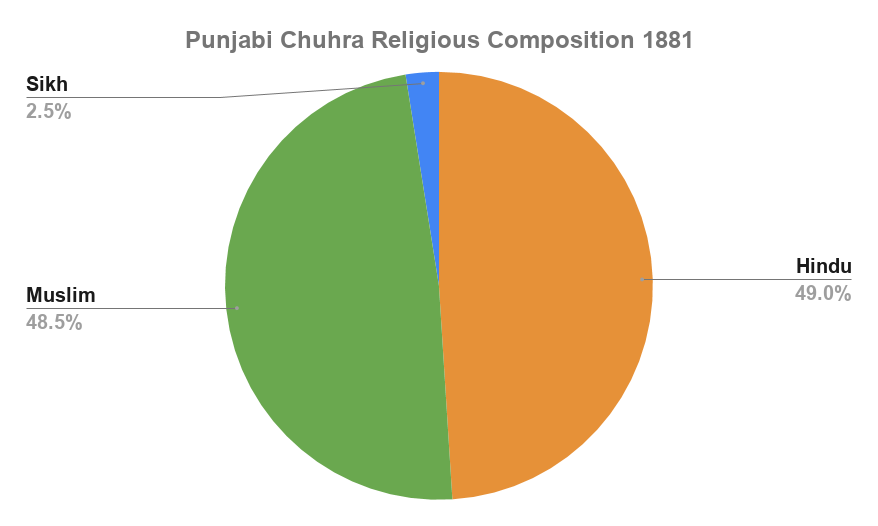https://araingang.medium.com/dalit-conversion-in-british-punjab-7d916e6315e9
Dalit Conversion in British Punjab

British Punjab was perhaps the most religiously dynamic region in all of South Asia during the colonial period. Christian missionaries, Dalit activists, Hindu reformers, Sikh preachers, and Muslim revivalists all jockeyed for position in a region traditionally not monopolized by any one faith. Local efforts, coupled with broader global trends sweeping through India, led to a number of religious changes among Punjabis during this period.
Thanks to British census records¹ we have the ability analyze the religious changes that occurred at both a tribal and regional level. The first group I’d like to discuss are the “Untouchables”, known in the modern period as Dalits. These tribes were traditionally found at the bottom of the Caste hierarchy, thought fit for only the most menial and degrading of tasks, and generally existed at the periphery of mainstream society.
The Chuhras and Chamars, comprising 35 and 65 percent of the Punjabi Dalit population respectively, will be the two tribes analyzed in this piece. Pictured below are graphs depicting their change in religious affiliation between 1881 and 1931.


As depicted above, while the Chuhra population was almost perfectly divided between Muslims and Hindus in 1881, by 1931 that was no longer the case. 40% of Hindu Chuhras and 27% of Muslim Chuhras appear to have converted to Sikhism, Ad Dharmi, and Christianity. This isn’t suprising, given that Ad Dharmi was a religion founded by and for Dalits, while Christian missionaries specifically targeted Dalits due to the latter’s disenchantment with the existing hierarchies. Sikhism also could have offered hopes of more egalitarian treatment, though its also likely that many Chuhras had in fact been Sikhs all along, but were recorded as Hindus due to the British census protocols² in place before 1911.

Here we see another movement out of Hinduism, with nearly 80% of Hindu Chamars converting to either Ad Dharmi or Sikhism. The Muslim share of Chamars appears to have largely held steady. The lack of converts to Christianity is interesting, and according to Sara Singha can be explained by the Chamars holding Chuhras in such low regard, that when the latter began to take an interest in the new faith, the former decided it simply was not for them.
Present Circumstances
While most of these religious communities above are still going strong today, the Ad Dharmis are notably absent. This unfortunately is by design. The young faith started by Dalits as a means of emancipation from the Brahmanical Caste System had drawn the ire of Hindus, who by the late British period, were growing increasingly insecure as their numbers in Punjab dwindled.
Following India’s independence the Hindu government refused to recognize Ad Dharmi as a religion, and going a step further, refused to provide the agreed upon affirmative action to any Dalit who did not register as a Hindu³. This effectively killed the Ad Darhmi movement, and while attempts have been made to revive it, a combination of government pressure and caste-infighting has rendered the movement impotent.
Notes
1)
Data from 1881 and 1931 Punjab Census, excluding Princely States and
those districts falling outside of traditional Punjab (Haryana and
Himachal regions).
2) Prior to the 1911 census the British would automatically classify many Punjabis as Hindus if they did not appear to be sufficiently orthodox with respect to Islamic, Christian, or Sikh practice. As religious lines began to harden and it became important to identify oneself with a specific faith tradition, many Punjabis, previously content with the broad label of Hindu, began to agitate against such a policy, and the British eventually relented.
3.) This “affirmative action” is known as the Reservation System in India, providing education, career, and in some cases political subsidies to those minorities traditionally exploited by the Hindu Caste System. This initiative was first started by the British, against heavy protest by upper-caste Hindus, and carried forward in post-independence India on the condition that communities must continue identifying as Hindu to receive benefits. Over the years some communities like Sikhs and Buddhists were granted recognition as separate religions deserving of Reservations, but other religions like Islam and Christianity, which upper-caste Hindus regard as threats for Dalit conversion, continue to be denied.
No comments:
Post a Comment